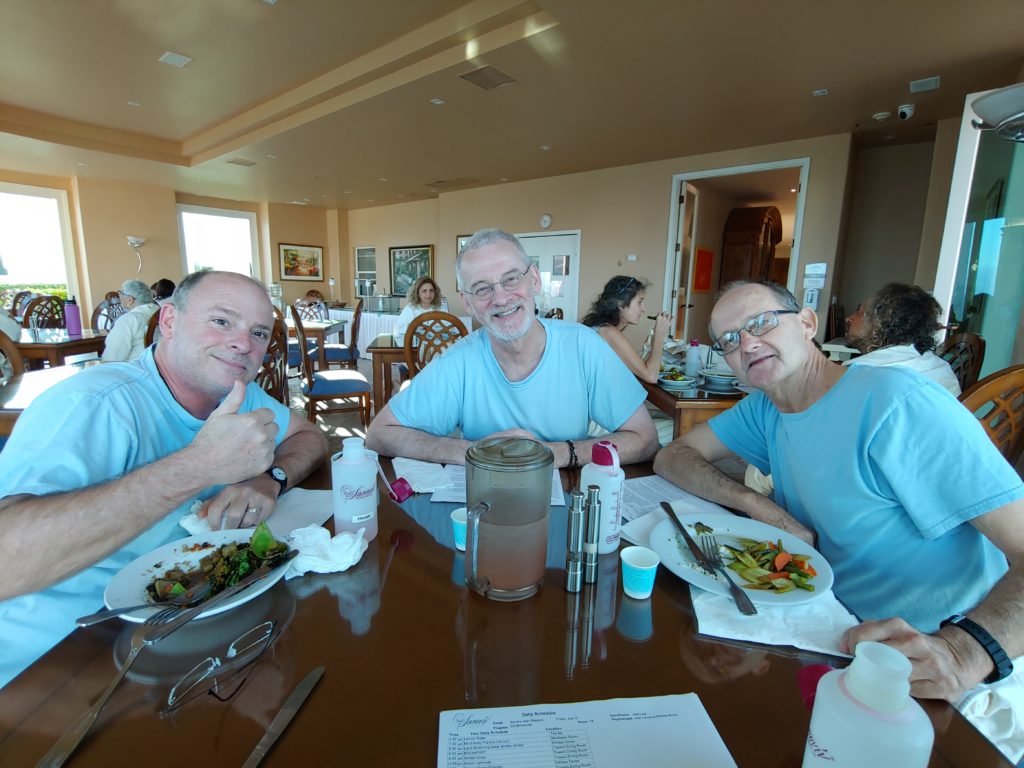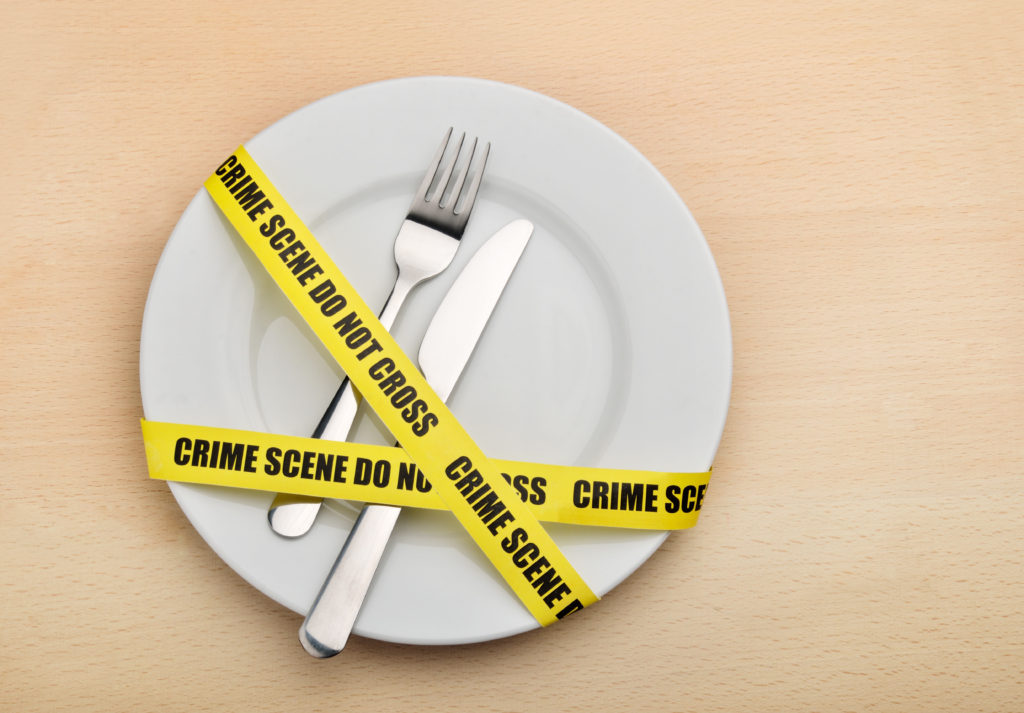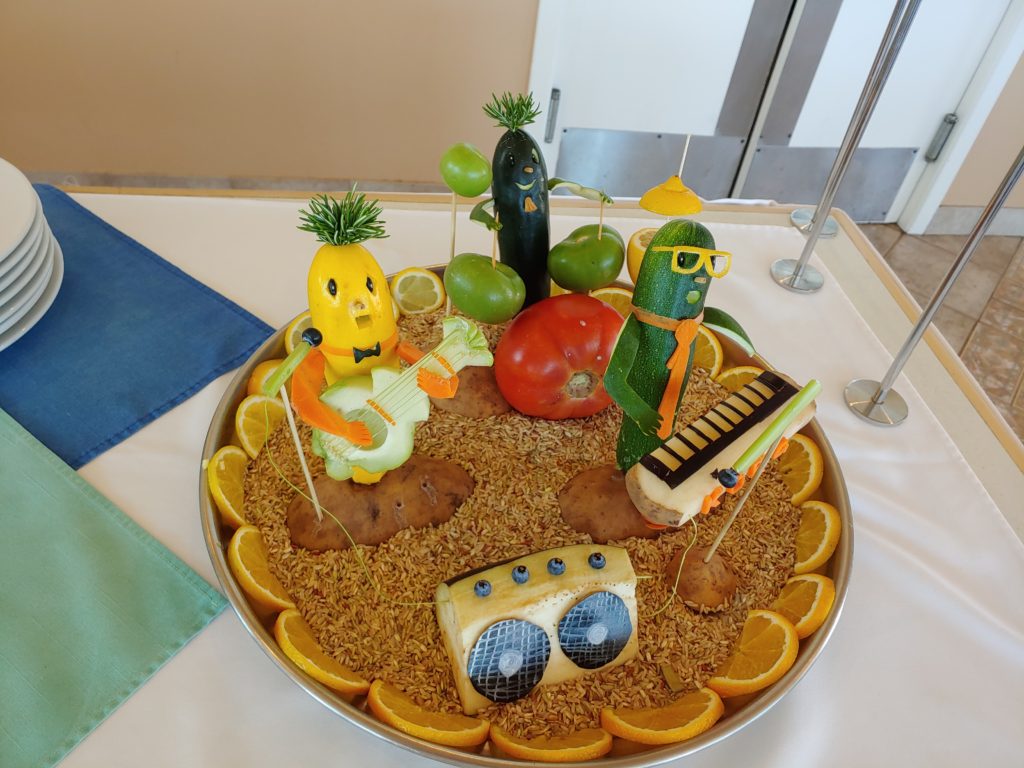
This blog post will be a compilation of a bunch of nutrition lectures that we have had while here. I believe that the Director of Nutrition, Sue Ward, is coming out with a book that addresses “diets,” which I am sure will be fantastic!
A book that was recommended (and I already have in my Amazon ‘cart’) is Mastering Leptin by Byron J. Richards, CCN.

The Five Rules of The Leptin Diet®
1. Never eat after dinner. Finish eating dinner at least three hours before bed. Allow 10-12 hours between dinner and breakfast. Allow at least 3 hours between dinner and bed – never go to bed “on food.” Sleep is prime “fat burning” (metabolic) time. NOTE: If you have problems with Rule #1, you likely have a significant problem with blood glucose metabolism, liver function, and/or leptin resistance.
2. Eat three meals a day. Allow 5-6 hours between meals. Do not snack! The need to snack is a sign of an out-of-shape pancreas/liver/muscle system. Because each snack forces your body to make insulin, etc., snacking is like a “repetitive strain injury” on your system.
3. Do not eat large meals. Eat until you are “not hungry,” not until you are “full.” Eating slowly is important, as how “full” you feel takes 20 minutes to get to your brain, after you reached that point. If you shovel food down, your body can’t signal properly. Cutting portion sizes and “putting your fork down” will help shrink and tone your stomach.
4. Eat a high protein breakfast. Aim for 20-30 grams of protein at breakfast. Metabolism increases +/- 30% for as long as 12 hours after a high protein meal. This would be like taking a 3-4 mile jog! If you don’t “feel like breakfast,” it’s likely that your system is full of toxic waste from the night before. Have a low protein dinner, to set your system up for success overnight.
5. Reduce the amount of carbohydrates eaten – especially “Food with no brakes.” Limit, don’t cut out, carbs. Without carbs, your thyroid turns off, growth hormone doesn’t get released, fat is not burned efficiently, you won’t have the “bulk” in your stomach to feel satisfied, and lots of other nasty, disregulatory things happen.

From the Sanoviv Newsletter:
Sue Ward writes the Newsletter for Sanoviv, which comes out monthly. The featured article for June was “40 Tips for Fat Loss.” (I wish I could link it, but you need to subscribe yourself.) Here are just a few of the suggestions – she asks the reader to consider just doing 4-5 of those on the list (the 5 above are on there, by the way).
- Support your liver by going through your house and eliminating processed foods and environmental toxins. These include shampoos, cleaning products, deodorants and the like. Pick up a replacement one, and “just see” if it works for you. If that one doesn’t – don’t give up!
- Have soup for dinner for 7 days, then wake up to a high-protein breakfast.
- Consume fermented foods. Sauerkraut, (live, non-sugar) yogurt, miso, etc. This can help balance your gut bacteria. Polyphenols are in a more active state in fermented food, which is also loaded with good gut bacteria.
- Eat enough fiber. This means 25-30 grams/day.
- Slow down and eat mindfully. Unconscious eating = mindless eating = overeating.
- Stop sitting so much. Sitting stops the circulation of lipase, the enzyme that breaks up fat in the body. Standing re-engages the fat burning enzymes. Yes, you can talk on the phone, watch TV, or the like while standing!
- Try a liquid day once a week. This gives the body a digestive rest, cleanses your system, and helps restore balance. This can be soups, smoothies, teas, green juices, or water.
- Control portions through smaller plates. Many of us were brought up with the “Clean Plate Club.” If you use a larger plate, you can misjudge how much is on it.
- Adjust meal timing to improve fat burning. Space meals 5-6 hours apart, don’t skip meals and do NOT snack. Combine with Intermittent Fasting for a bigger boost.
- Use Vitamin C to reduce cravings. Linus Pauling’s research showed that Vitamin C competes with sugar for the entrance to your cells. The more sugar in the system, the less Vitamin C can get in. One study showed that adults with Vitamin C deficiency were more resistant to losing fat, whereas those with adequate Vitamin C levels burned 30% more fat during exercise. This does NOT mean “pop a Vitamin C gummy” or drink fruit juice however! Eat FOODS high in Vitamin C. (Thyme and Parsley, anyone? They beat oranges!)
- Try a veggie-only day once a week. Start with a green smoothie, a large salad for lunch, and a plate of stir-fried veggies for dinner. No grains, fruit, or meat. You can also try replacing one meal per day for a week with veggie juice, which is a great way to boost antioxidants and phytonutrients without added calories. No, this doesn’t mean V-8! Try to make your own at home if you have the “machinery,” or opt for one from an organic purveyor without added salt, etc. Remember – the longer a product has been in the “bottle,” the less “fresh” it is for your body. Moreover, if a product you purchase isn’t in a dark bottle, the antioxidants are going to be working hard – on the sunlight that’s affecting the juice!

Miscellaneous Notes
We have had a lot of Nutrition workshops and seminars here. I saved out my notes from the “Notes” blog and am putting them here instead.
- Digestion begins in the brain. Just think of something super tasty for you – or even sucking on a lemon. Your brain will tell your mouth that this food is on the way, and your salivary response will start. This why somewhat easy things – like just taking a second and saying Grace over a meal (even if you’re not religious, you can thank the farmers and ranchers who brought it to you) can get your brain to send the right “signals” to the rest of your body with respect to what’s coming. Giving gratitude over a meal is also positive talk about that meal for your body, which will be more receptive. If you’re “sneaking” food, bolting food, or eating “mindlessly” you have subconsciously given your body the signal that it’s not good for it. And what does the body do with substances like that? Wraps each molecule up with fat and stores it at your waistline.
- Chew more. Count your chewing “baseline” for a meal. (Yes, this counts as Mindful Eating.) Then, try to double it. The more broken down an item is before it gets to your stomach, the less hard it is for your stomach and the rest of your system to deal with it.
- Leaky gut is found in the small intestine. Yes, it’s a real thing. Basically due to damages done from foods and toxins, the wall of your small intestine is permeable, which allows food particles to “leak out” into your system. So, instead of having the parts of a meal that are supposed to be in your blood (amino acids from protein, from example), you actually have a small piece of that meal in your blood. Your system doesn’t know what to do with it. This can lead to a cascade effect. (Example: Your thyroid can view a gluten molecule as the same shape as its own tissue – so “seeing” a gluten molecule can cause it to attack itself. The gluten molecule wouldn’t be there without you having leaky gut – it would have been broken down into the composite protein parts (e.g., gliadin, glutenin, proline, glutamine, secalin, hordein, etc.) Gut healing foods include aloe vera (do not buy a “blend” or one that has sugar in it! Try to get organic. It is available at Trader Joe’s and is tasteless), bone broth, healthy fats (such as ground flax seed and avocado). There are also Gut repair nutrient supplements such as GI Revive.
- you should have 1-3 bowel movements per day. They should look “fluffy” and hold together. If you are not, you can take magnesium citrate (not any other kind) to help with constipation, but should up your fiber to at least 30 grams per day, plus water. You can also take 12 grams/a rounded tablespoon of ground flax seeds, psyllium, or inulin (which is also a prebiotic), but you must take enough water with these, as they will all be constipating without it. If you have an issue with “stopping up the plumbing” with your bowel movements, release 1/2, flush, release the other 1/2, flush, THEN use the paper (and flush). (TMI?)
- Two cans of regular soda/Monster/etc. (24 teaspoons of sugar) decrease the efficiency of your white blood cells by 92% for 5 hours. In other words, this “crashes” your immune system and makes it completely unable to fight any “immune-response” thing going on in your body (arthritis, flu, etc.)
- If you take a med such as Prilosec, it actually decreases your stomach acid – the stomach will sense this, and make more and more and more. You need instead of take a supplement that will supplement your stomach system (I’ve mentioned this in a post before, because I mentioned that the Designs for Health product has H-Cl and was recommended as better for me than the USANA product). The alkaline of a product like Prilosec just buffers the stomach acid and decreases your digestion ability by an enormous factor.
- HealthyTraditions.com has lists that include where you can find glyphosate-free oats, etc. Cornucopia.org has a list about egg purveyors and also yogurts. (Spoiler Alert: Trader Joe’s “organic, free range” eggs are nothing of the sort.)
- Glutens have a substance in them that are called “gluteomorphins.” What does that sound like? Yes, Morphine. They react the same way. And you wonder why you can’t stop reaching for the bread basket?
- Wash all your fruits and veggies. Soaking them in 1 ounce of aluminum-free baking soda combined with 100 ounces of water for 15 minutes has been proven in a test to get pesticide residue out from under the skin of apples. As I’ve said before, go to EWG.org to get the “Clean 15” foods that you can buy conventionally and the “Dirty Dozen” foods that you need to buy organic. If you give them a small donation you will get a grocery bag tag that contains these lists.
- Resistant Starch. Your probiotic/gut biome needs “prebiotics” to grow and live. The best choices are three foods that we have been told now basically to never eat: white rice, white potatoes, and pasta. What’s the catch? You have to eat them cold. By way of example, rice has 4 calories per gram when it’s hot, and 2 when it’s cold. How do you do this? Make a cold rice salad, potato salad, or pasta salad. No mayo or sugar though! Make it with vinegar (e.g., “German” potato salad). If you combine resistant starch with live culture foods (sauerkraut, live culture yogurt), you get double the benefit.
- Do not take probiotics on an empty stomach. The probiotics need to make it down into your small intestine, and your stomach acid kills them. If you feel the need to take a probiotic supplement, HERE is one that is strongly recommended – and if you take a good probiotic like this with food poisoning, it will “mop up” what is causing you to get sick. Take it as soon as you feel that you “might” have eaten something bad.
- Lack of sleep and insulin resistance: A study showed that if you go from 8 hours to 6 hours of sleep a night, you can build up insulin resistance in two weeks.
- Type 2 Diabetics should consider eating only two meals a day. Eating at 10 and 4 will allow your body to rest between having to make insulin. If you keep snacking, you never stop making insulin, and your body will never go to your fat stores to get energy.
- Mark Hyman (who has a zillion books) trained at Sanoviv about eight years ago, for his functional medicine institute. All of his books pretty much recommend the same eating plan – which is basically the Sanoviv eating plan.
- The Gabriel Code. About a zillion years ago (I checked my cloud files – yep, a zillion) I subscribed to the meditations, etc. that the author of this book put out. I never finished them because – SQUIRREL!!!! But I have just saved them from my “Diet and Exercise” cloud folder to my “To Read” cloud folder. The 10,000 ft. view of this book and the system is that this guy lost like 300 pounds by changing the way he thought. He also did it very slowly, so wound up not having “hanging skin” and the rest. His book and meditations have to do with the fact that when you’re under stress, etc. that your body “hides you” under mountains and mountains of fat. Hey, “Nobody bothers the elephant in the jungle.”
- The Plant Paradox. This is a book that I’ve read, that reminds me a bit of the book How Not To Die, but it is really based upon lectins and has some suboptimal things in it. One is that it recommends “quorn,” which is a highly processed, engineered food which is terrible for you (there are lawsuits involved). It also has way too many complicated supplements that are low quality, and doesn’t include any animal protein, which can lead to body complications. Many foods that are eliminated are rich in important nutrients where cooking, soaking, sprouting and fermenting them can significantly decrease their lectin content. So, if you’re super sensitive to lectins, maybe this will help you, but for the bulk of folks, cooking foods prior to eating and following a healthy, balanced diet is likely a better alternative. Though a lot of these diet plans are “compelling,” as Sue said in her lectures, all these books will convince you to throw out everything that you have and move onto whatever it is that they’re suggesting.
So, what are you going to start doing – next week – from this list to lead to a more healthful life?? Let me know in the Comments – I’m curious!



Great advice! I already follow the 3 meals a day, eaten every 5-6 hours, no snacking after dinner, 14-16 hours from dinner to breakfast. And I finally lost 13 pounds that have been stubbornly following me around for the past several decades. I’d love to try soup for dinner for 7 nights, but no way hubby will go for that. But I commit to trying one liquid day a week and might also try one veggie day. I also signed up to get the Sanoviv nutrition newsletter. Thanks, Sandy!
Wow, there is a lot of good info here. One thing that surprised me was the “no snacking between meals” tip. I thought snacking during the day (ahem, *healthy* snacking) was good. So instead of 3 (larger) meals, you’d have ~5 smaller meals/snacks. Drat.
@Kathryn – might be for you – but for anyone who has extra fat going, it means that you never give your body a break to go “get” energy from your “stores.” Once you think about it, it’s (frustratingly) logical.